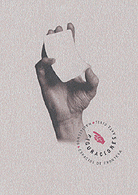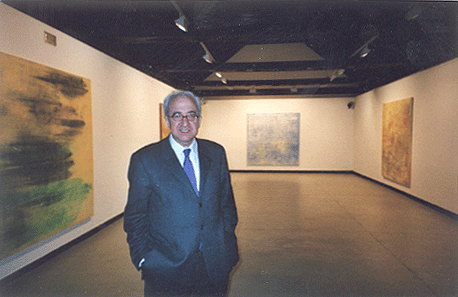FIGURACIONES. Arte Civil, Magicismos y Espacios de Fronteras.
GROUP SHOW: (From 1- 26 to 4-27 2003)
CAJA MADRID. OBRA SOCIAL.
Auditorio de Galicia. Avda. Burgo das nacions s/n. Santiago de Compostela
Commissioner: José Marín-Medina

ALBERTO REGUERA
(Text by José Marín-Medina published in the exhibition catalogue)
Where is one to place Alberto Reguera as an artist in the current state of affairs, when the postmodern model or representative type is the "artist-manager," who, in the words of Jacques Aumont, "manages his artistic activity like any other activity, who makes decisions and assumes the associated risks, evaluates strategies and finds the means to put them into practice?"
Where to place an artist who paints exactly like a romantic landscapist and an abstract expressionist, dedicated to the irresistible allure of facing a blank canvas, palette in hand, with absolute faith in the act of painting? Alberto feels at every moment that he is a painter and considers himself to be a definitive causa del arte. That is why he understands that the ultimate motives of art do not reside in the models, but in the author of the work, the painting's creator.
Alberto is in part classical artist, as demonstrated by his interest in representing the beauty of nature. He is in part romantic artist, as we suggested earlier, in that his vocation is to take part personally in the transcendental truth of the world and to express it. And he is in part modern artist, as shown by his constant awareness of his responsibility as original creator and author. In effect, his work is more than strictly pictorial, it is pintura de autor.
Again, where is one to place his painting, so abstract and self-expressive, yet at the same time so full of climates, atmospheres and landscapes? Critics have tried to explain it in various ways, and the observations of Huici and Solana seem to me particularly suggestive. Fernando Huici believes-in terms of geographical location-that we have before us a style of painting that is essentially oriented toward the north, referring to post-avant-garde Paris, the city that shares with Madrid the residence, time, and work of Alberto Reguera, and the place that currently exerts such an influence on some of our outstanding artists such as Barceló, Broto, Campano, and Sicilia. Guillermo Solana, on the other hand, resorts to technical or process-related features to explain the exceptional character of this painting: "Since the time of Monet, the material nature of painting has become more evident and more difficult to reconcile with optical illusions. Alberto Reguera has incorporated into his work, from early on, the most radical material investigations, such as various types of grattage and frottage, and he has explored the tensions, eruptions, and shatterings of the painted surface. But through these physical manipulations, he has never failed to bring about a marvelous metamorphosis, a sublimation of the material. In his works of some years earlier where he dragged and rubbed the paint, the reflections in water and windows expand into the distance. There are techniques that seem especially suitable for this optical sublimation. For some time, Reguera has been sprinkling powdered pigments in a fine mist over the still wet surface of the painting; this splash of color sometimes crosses the canvas like a violent gesture, or sometimes falls in a delicate vertical cascade."

José Marín-Medina (Exhibition Coordinator)
I am in complete agreement with the northerly orientation of this painting, and not only with respect to the importance of Paris, but expanding it to other horizons: I refer to the frequent travels of our painter in the Netherlands and other northern lands. There are painters who travel a great deal-especially landscape painters-and among them, Reguera is an incessant wayfarer, who goes through the world finding those same climates and atmospheres, the same lights, shadows, and mists, the same superimposed materials and radiant cascades of light, the same marshes and grand summits that, paradoxically, he has already painted. For it seems that Alberto does not travel to paint, but to encounter the geography of what he has painted. In effect, those northern landscapes that he prefers are in harmony with authentic landscape painting, which always justifies itself through abstraction; that is, to a greater or lesser-but substantial-degree, through the act of abstracting, imposing the pictorial aspect on the model and the visual fact, resulting in the triumph of what Roald Nasgaard calls "the theory of description," in which equal importance is afforded to what is seen, intuited, felt, and imagined.
I also agree with the relevance of processes and techniques for explaining this type of painting and broadening its spectrum to include spatial considerations. I believe that the representation of a particular space is the fundamental theme in the work of Alberto Reguera. It is an atmospheric space that penetrates the domains of the unlimited as forms gradually lose their precision, inasmuch as an atmospheric representation necessarily disturbs the clarity of the drawn form and the lineal definition, creating simultaneously a climate of emotions. It is that same emotion that the baroque painters favored, when, through their approach to the unlimited, they represented for the first time the values of a cosmic space, creating a dialogue between the intuition of the real and the expression of the purely ideal. Later, the impressionists and post-impressionists advanced until they were able to make the air itself become substance in their painting, becoming confused with the realities that it envelops, turning plastic space into a purely sensual experience, and merging into a single pictorial reality what had earlier been separate elements, such as figure and background, image and vessel. It is a lyrical spatialism, wherein we find fulfilled the Pythagorean principle that space is confused with material, and where we find many artists that have been inspired by Reguera, such as Hartung, Schneider, Soulages, and Mathieu, whose bold brushstrokes approach the energy of the American abstract expressionists.
From these paintings of northern landscapes and these mystical spaces, so aerial, spacious, and open, Alberto Reguera returns us to a style of painting that is explicitly emotional, intersected by a desire or nostalgia for lost quality, the sensation of truth, the intuition of beauty, and the domain of aesthetics.
José
Marín-Medina
(Exhibition Coordinator)
Catalogue for the exhibition FIGURACIONES, Arte Civil Magnicismos, Espacios
de Frontera, Obra Social Caja Madrid.